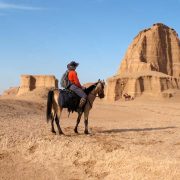Lut Desert named World Heritage Site
Iran expedition to explore new UNESCO World Heritage Site;
Today, on 17 July 2016, eight new sites of global importance were inscribed to UNESCO’s World Heritage List including the Lut desert (the Dasht-e-Lut) in the Islamic Republic of Iran.
“Our Lut team has a few places remaining this October and we welcome applications from anyone with a fit and healthy lifestyle who is keen to join this tough desert trek through an environment recognized by UNESCO as being of global importance.”
The Lut: Nine interesting facts:
1. Hottest place on earth
Iran’s Lut desert is home to the hottest recorded spot on the earth surface according to NASA’s satellite data of land surface temperature. 70.7°C was recorded there in 2005 and the Lut has taken the hottest top spot on several annual occasions since.
2. World-first crossing on foot in 2015
A Secret Compass expedition team was the first group ever to traverse Iran’s Lut desert on foot, as featured in National Geographic magazine in May 2016 by award-winning photojournalist Mark Stratton. Marco Polo is alleged to have visited the region in 1271, and Wilfred Thesiger visited in 1964.
3. Yardang formations
Between June and October, the Lut desert is swept by strong winds which transport sediment and cause erosion on a colossal scale causing spectacular ex aeolian yardang formations – vast corrugated ridges also known as kaluts. The yardangs are described by UNESCO as ‘an exceptional example of ongoing geological processes’ and form the longest yardang system in the world at 120km long and 80km wide. Some can reach 80m in height.
4. Silk Road links
The expedition team will pass through key Silk Road locations. The nearby city of Bam was the crossroads of important trade routes from east to west from the seventh to eleventh centuries.
5. Sand dunes and star dunes
The terrain and geological features of the Lut desert include unusual sand dunes, wind-sculpted star dunes and salt plains and polygons, vestiges of former seas and inland lakes.
6. Meteorites
The Lut desert has been classified as having high potential for finding meteorites due to its persistently dry climate. A small collection known as the Valley of Meteorites has already been discovered.
7. Salt plains in the desert
In the central Lut lie massive flat plains where saltwater has accumulated and been evaporated by the ferocious sun leaving various shapes over the barren landscape. This expedition does not pass the plains but explores a former inland lake whose evaporated banks offer a similar example.
8. The city of Kerman
Kerman is one of Iran’s oldest cities and was once the staging point for traders passing between Persia and the Indian Subcontinent. The Secret Compass team will fly from Tehran to Kerman to begin their Lut desert traverse expedition.
9. New UNESCO World Heritage Site
As at July 2016, the Lut desert became one of the world’s newest UNESCO-inscribed heritage spots for its unique desert environment, its rock paintings and its natural sand dunes and formations.


